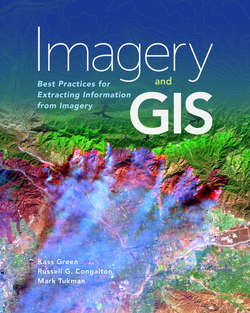Читать книгу Imagery and GIS - Kass Green - Страница 49
На сайте Литреса книга снята с продажи.
Spectral Resolution
ОглавлениеThe spectral resolution of an image is determined by the sensor and refers to the following:
The number of bands of the electromagnetic spectrum sensed by the sensor
The wavelengths of the bands
The widths of the bands
Panchromatic sensors capture only one spectrally wide band of data, and the resulting images are shades of gray, regardless of the portion of the spectrum sensed or the width of that portion. Panchromatic bands always cover more than one color of the electromagnetic spectrum. Multispectral sensors capture multiple bands across the electromagnetic spectrum. Hyperspectral sensors collect 50 or more narrow bands. Traditionally, multispectral bandwidths have been quite large (usually 50 to 400 micrometers), often covering an entire color (e.g., the red portion). Conversely, hyperspectral sensors measure the radiance or reflectance of an object in many narrow bands (usually 5 to 10 micrometers) across large portions of the spectrum, similar to imaging spectroscopy in a chemistry laboratory.
Film images are stored as negative or positive film or paper prints. Remotely sensed digital data files are stored in a raster or rectangular grid format. When imaging, each picture element, or pixel, collects a digital number (DN) corresponding to the intensity of the energy sensed at that pixel for each specific band of the electromagnetic spectrum. Panchromatic data is stored in a single raster file. Figure 3.13 shows example infrared DNs for a small area.
Figure 3.13. Example infrared digital number (DN) values
Multispectral images store each band as a separate raster. Each band is monochromatic, but when they are combined they can be displayed in color. Figure 3.14 shows four separate bands of airborne digital imagery collected over a portion of Sonoma County, California. Each band is monochromatic. Figure 3.15 combines the bands to create true color and color infrared displays.
Figure 3.14. Red, green, blue, and near infrared bands of airborne multispectral imagery captured over Sonoma County, California (esriurl.com/IG314)
Figure 3.15. True color and infrared combination of bands of airborne multispectral imagery collected over Sonoma County, California (esriurl.com/IG315)
The bands shown in figures 3.14 and 3.15 are in the red, green, blue, and near-infrared portions of the electromagnetic spectrum. Each pixel of the imagery contains four numbers, one for the DN recorded in each of the four bands. Table 3.2 presents the range of DN values for each band of the different land-cover types depicted in figure 3.15.
Table 3.2. Range of sample DN values
Notice how water is significantly lower in the infrared band than are the other land-cover types. Also, urban has high values in all bands relative to the other classes. Riparian vegetation and water are similar in the red, green, and blue bands, but significantly different in the infrared band, indicating that without the infrared band it might be difficult to distinguish the greenish water from the green vegetation.
At this point, we can begin to see how variations in land-cover types can be related to variations in spectral responses, and it becomes straightforward to group the similar pixels of the image sample in figure 3.14 together into land-cover classes, as depicted in figure 3.16. Of course, it is never quite this straightforward to turn image data into map information, which is why chapters 7 to 9 thoroughly examine the methods and tools for image interpretation and classification.
Figure 3.16. Infrared DN values from figure 3.13 combined into land-cover classes
